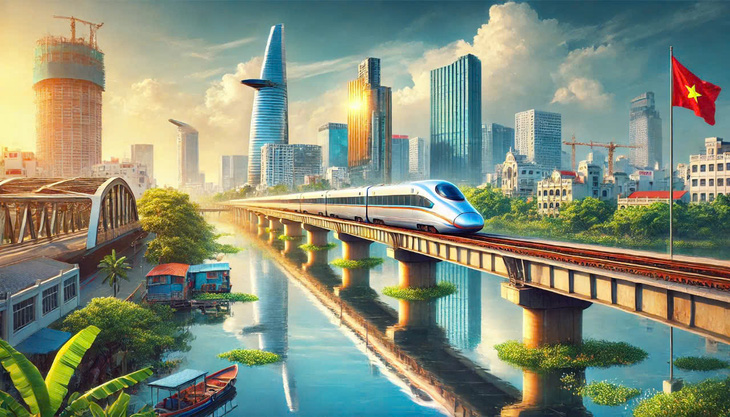The Ministry of Transport clearly stated the selection of a design speed of 350km/h for the North-South high-speed railway to meet modern criteria, the investment rate is not expensive compared to other countries.
Illustration
In the afternoon of November 20, the National Assembly discussed in the hall the investment policy of the high-speed railway project on the North-South axis.
Previously, the Ministry of Transport had explained, absorbed and clarified groups of issues on the investment policy of the North-South high-speed railway project.
Why choose the speed of 350km/h?
Accordingly, there is an opinion that initially it can be studied at a more suitable level of 250km/h, both carrying passengers and cargo.
Regarding the above content, the ministry stated that the speed selection has been thoroughly and comprehensively studied, synthesizing experience in high-speed railway development.
The results of the study show that the speed of 200-250km/h developed about 50 years ago and was popular in the period about 25 years ago, suitable for short and medium routes.
The speed of 350km/h and higher is a development trend in the world, suitable for routes of 800km or more, concentrated in many cities with high population density such as the North-South corridor of our country.
World experience shows that with a length of 800km, a speed of 350km/h is more attractive and has a higher ability to attract passengers than a speed of 250km/h.
According to the consultant’s calculations, on the Hanoi – Ho Chi Minh City route. Ho Chi Minh City at a speed of 350km/h has the ability to attract passengers about 12.5% higher than the speed of 250km/h; the investment cost of 350km/h is about 8-9% higher than the speed of 250km/h.
However, if you invest at a speed of 250km/h, upgrading to a speed of 350km/h is difficult and ineffective.
Therefore, it is proposed to choose a design speed of 350km/h for the North-South high-speed railway to meet the criteria of modernity, synchronization, long-term vision, efficiency, and suitability to our country’s geoeconomic conditions.
The investment rate is 43.7 million USD/km at an average level
The Ministry of Transport also stated that the project has a total investment of about 67.34 billion USD, the investment rate is 43.7 million USD/km.
Compared to other countries in the world, this is the average when converted to 2024 as follows: Germany’s Nuremberg – Ingolstadt route, operating speed 300km/h, investment rate of 60.5 million USD/km.
The comparison of investment rates between projects is also only relative because it depends on many factors such as technology, topographic conditions, geology, hydrology, scale, technical standards, localization ability, etc.
For Vietnam’s high-speed railway, the technology has not been selected in detail, so the expected investment rate in the pre-feasibility study report is acceptable and will continue to be reviewed and calculated specifically in the process of making investment projects and the next steps.
The explanation of the Ministry of Transport also clearly indicates that the project is expected to be allocated from the state budget in the medium-term public investment plan periods to invest in completing the project in 2035.
The capital allocation period is about 12 years, with an average of about 5.6 billion USD per year, equivalent to about 16.2% of the medium-term investment plan for the 2026-2030 period if the medium-term public investment rate of 5.5-5.7% of GDP remains the same.
About 1.3% of GDP in 2023, about 1.0% of GDP in 2027 (project start-up). The implementation process will mobilize a variety of legal capital sources for investment.
In addition, in this term, 3,000km of investment has been completed and about 1,700km of expressways are being implemented.
Therefore, the investment pressure to reach 5,000km of expressways by 2030 according to the resolution of the 13th Congress is not large, the medium-term public investment plan in the next period can balance investment, not much impact on economic development goals.
Preliminary assessment of the impact on public debt safety indicators when implementing project investment shows.
By 2030, all 3 criteria (public debt, government debt, foreign debt of the country) will be lower than the permissible level. Two criteria (the country’s foreign debt repayment obligation and budget deficit) increased compared to the permissible level.
After 2030, the public debt criterion will be lower than the permissible level; other criteria increase but not much compared to the scenario of not investing in high-speed rail.
The above scenario for evaluating the public debt safety target has not taken into account the project’s contribution to GDP growth during the construction period.
The cost of investment in means and equipment will be reimbursed by the Vietnam Railways Corporation; revenue from land fund exploitation in TOD and commercial exploitation areas.

